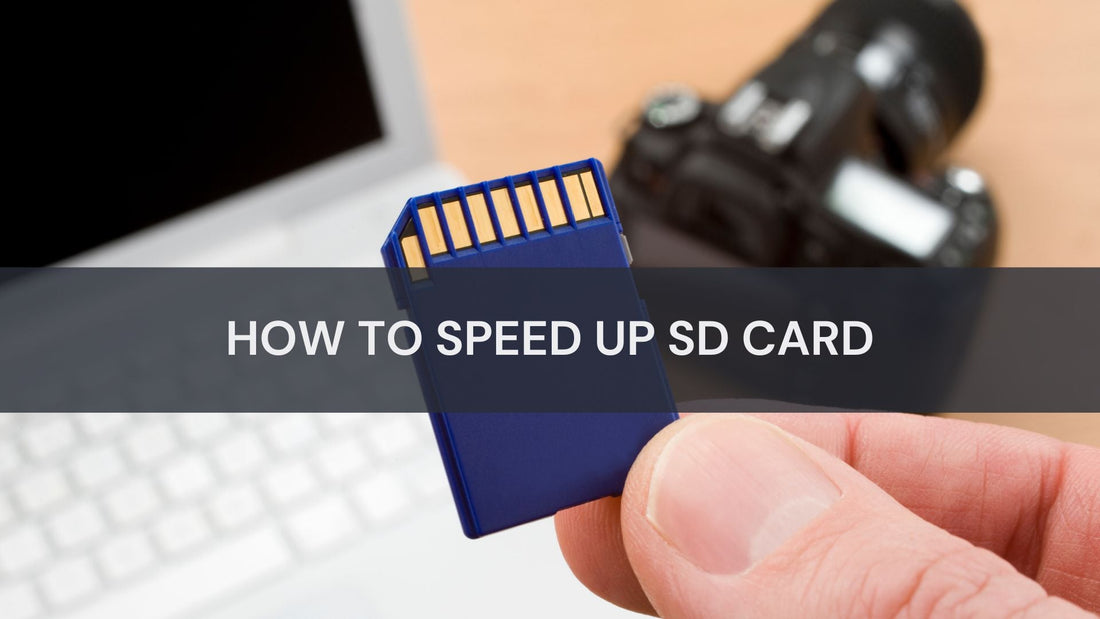
How to Speed Up SD Card: Best Practices to Optimize Performance and Storage
Share
How to Speed Up Your SD Card: Best Practices to Optimize Performance and Storage
Introduction: Why SD Card Speed Matters
If you’ve ever struggled with slow SD card speeds, you know how frustrating it can be. Whether you’re a photographer shooting high-resolution images, a videographer filming in 4K, or a gamer saving Nintendo Switch progress, a sluggish SD card can slow down your entire workflow.
The good news? There are proven ways to improve SD card performance and maximize both speed and storage efficiency. In this guide, we’ll cover the top 8 methods to speed up your SD card and extend its lifespan.
1. Choose the Right SD Card to Begin With
Not all SD cards are created equal. Performance depends heavily on the card class, speed rating, and brand reliability.
- Speed Class Ratings: Look for Class 10, UHS-I, UHS-II, UHS-III, or V30/V60/V90 cards for smoother 4K and burst photography.
- Bus Speed: Higher UHS ratings = faster transfer and recording performance.
- Application Class (A1, A2): Better for smartphones and tablets running apps.
- Trusted Brands: Stick with SanDisk, Samsung, or Lexar to ensure speed, durability, and warranty support.
✅ Pro Tip: If you’re shooting 4K video, choose UHS-I U3 or V30 cards at minimum.
2. Use a High-Speed Card Reader
Your card is only as fast as the reader you plug it into. Avoid old or generic readers that can bottleneck performance.
- Use USB 3.0, USB 3.1, or Thunderbolt readers for faster transfers.
- Ensure compatibility with UHS-II/UHS-III if your card supports it.
3. Regularly Format Your SD Card
Over time, files and system logs can clutter an SD card and reduce efficiency. Formatting helps maintain speed.
- Format in the Device: Always format in the camera, phone, or console you’ll use it with.
- Quick Format vs. Full Format: Quick format clears the index fast; full format can fix deeper file fragmentation issues.
4. Keep Your SD Card Clean and Protected
Dust, dirt, and damage can directly impact card performance.
- Use protective cases and avoid bending or dropping cards.
- Clean the metal contacts gently with a microfiber cloth.
5. Avoid Overloading Your SD Card
Running your card at near full capacity can slow it down.
- Keep at least 10–20% free space to maintain write speeds.
- Regularly transfer data to a computer or cloud storage.
6. Update Firmware and Device Drivers
Slow speeds may be due to outdated firmware or device drivers.
- Check manufacturer websites for firmware updates (camera, phone, or card reader).
- Updating can improve compatibility and performance with newer cards.
7. Optimize File Transfers and Recording Settings
- Enable Write Cache in your operating system (Windows/macOS).
- For video, lower unnecessary bitrates to avoid buffer delays.
- Use the fastest ports (USB 3.0+, Thunderbolt).
8. Test Your SD Card Performance
If performance issues persist, test your card speed to check if it’s underperforming.
- CrystalDiskMark (Windows)
- Blackmagic Disk Speed Test (Mac)
- A1 SD Bench (Android)
This helps identify if the problem lies with the card, the reader, or the device.
Conclusion
By following these best practices — from selecting the right card to maintaining it properly — you can dramatically speed up your SD card, extend its lifespan, and optimize performance for 4K video, photography, and gaming.
For high-performance SD cards at the best prices in Canada, shop trusted brands like SanDisk, Samsung, and Lexar at TopSelect.ca.
Quick Summary: How to Speed Up an SD Card
| Method | What It Does | Why It Helps |
|---|---|---|
| Choose the Right Card | Pick Class 10, UHS-I/UHS-II, V30+ cards from trusted brands | Ensures faster base performance for 4K/HD recording & apps |
| Use a High-Speed Reader | USB 3.0/3.1/Thunderbolt with UHS support | Prevents bottlenecks during file transfers |
| Format Regularly | Clears old file system data | Restores write speed and efficiency |
| Keep Card Clean & Protected | Avoid dust, dirt, and physical damage | Prevents read/write errors and slowdowns |
| Avoid Overloading Storage | Keep 10–20% free space | Maintains optimal write speeds |
| Update Firmware & Drivers | Update camera, phone, or reader firmware | Improves compatibility and speed |
| Optimize Recording Settings | Enable write cache, adjust bitrates | Reduces buffering and transfer lag |
| Test Performance | Use tools like CrystalDiskMark or Blackmagic | Identifies slow cards or faulty readers |
FAQs – How to Speed Up an SD Card
Q1: Why is my SD card so slow?
- Most slowdowns are caused by using a low-speed card, outdated readers, or nearly full storage.
Q2: Does formatting an SD card improve speed?
- Yes. Regular formatting clears unused system data and helps restore performance.
Q3: How do I speed up my SD card for 4K video?
- Use UHS-I U3 or V30-rated cards with a high-speed reader, and always keep 10–20% of storage free.
Q4: Can I fix a physically damaged SD card?
- Physical damage usually can’t be repaired. Backup data immediately and replace the card.
Q5: What’s the best SD card brand for speed and reliability?
- SanDisk and Samsung consistently rank as top performers.
